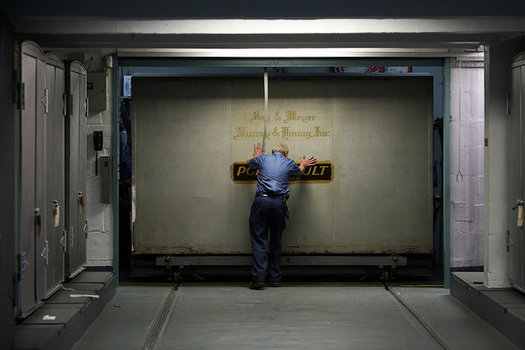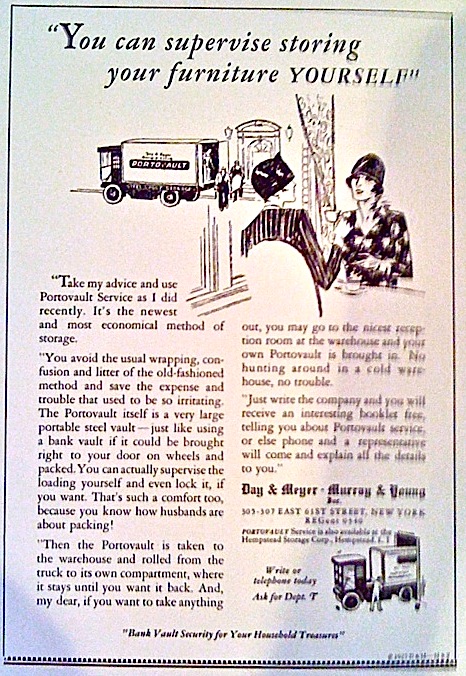
A couple of weeks ago, while waiting for my daughter at the Manhattan terminus of the Roosevelt Island Tram, I was attracted to a largely windowless tower a few blocks to the north. It seemed a remnant from a time long past, which indeed it was. Some investigation revealed it to be the warehouse of Day & Meyer, Murray & Young company, which has been the storage venue of choice for New York society since it opened its doors in 1928. This building became more and more interesting the more I learned about it, revealing itself to be more than just a warehouse of physical objects, but a mainframe of urban memory. Its history is the subject of my feature in the Metropolitan section of this Sunday's Times.
From an architectural perspective, what is most remarkable is what is behind the tower's mute facade: a unique system of steel vaults that move through the building on rails. These "Portovaults" have been in continuous use since the Jazz Age, and have safeguarded the materials of bold-faced New Yorkers from William Randolph Hearst to Norman Mailer to Whoopi Goldberg.
An excerpt:
The building was designed by Moores & Dunford, a Chicago architecture and engineering firm that specialized in industrial buildings with innovative technical features — conveyors, elevators, spiral chutes — customized for handling freight....Day & Meyer’s new warehouse had a climate-controlled vault for paintings and silver, and an entire floor set aside for storing grand pianos. It could hold 50 of them, all standing on their legs. An early brochure boasted of an entire floor devoted to unused automobiles, but the idea was jettisoned. The basement had a vault for carpets that was lined with cedar (to repel moths), and a separate space for steamer trunks that is now used for file storage.
But what set the place apart was its Portovault storage system, promoted in advertisements as “a new way of removing your treasures, reducing the confusion of storage to a minimum."
The innovation was that it could be delivered to the door of a client on the firm’s armored Diamond T truck, loaded, locked and then returned to the warehouse.There, the architects had installed a rail system, so that each unit could be routed from the loading dock into a large freight elevator, and then onto its designated floor and into its assigned space. The building, which can hold more than 500 of the units, is in a sense a giant storage rack.
The Portovault units look a lot like modern shipping containers, which they predate by more than two decades. Each Portovault is essentially a steel safe, 11 feet long and tall enough to stand in, that can hold the contents of a typical one-bedroom apartment. It weighs almost a ton when empty but has four small steel wheels that allow it to be pushed along runners by a lone workman.

Left: 1928 Advertisement for Day & Meyer's Portovault service. Right: Society ladies in fur inspect the contents of a Portovault in a company promotional photograph.
The advantage of the system is that once the client's stuff is in the Portovault, it does not have to be unpacked again at the warehouse. When clients want to inspect their goods, they come to the warehouse, and their Portovault is delivered down to a heated area in the basement, where they can rummage around at their leisure.
This system reminded me of the pneumatic tube networks that used to cross the city, and that until recently you could find in use at the NYPL and Brooks Brothers. The difference, of course, is that this one is still in operation. So you might say it is a time capsule that holds time capsules.
